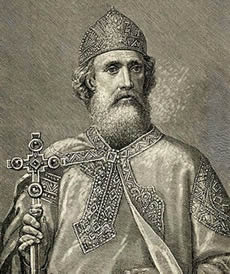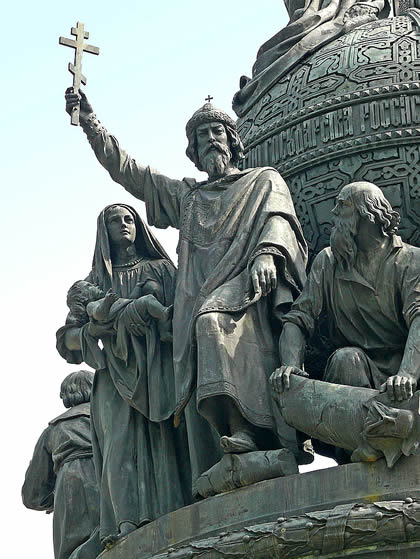World History
Vladimir was a descendant of the ninth century Scandinavian chieftain Rurik, whose successors established control along the Dnieper and other river routes that connected Scandinavia to the Black Sea.
Kiev became the political and cultural center of the new principality that was ruled by the descendants of Rurik, known as the Rus, through the 16th century. This land eventually became known as Russia. Vladimir’s father, Sviatoslav, appointed him prince of the northern city of Novgorod in 970.
Upon his death in 972, civil strife emerged and Vladimir fled to Scandinavia. Returning in 980, he defeated his brother and gained control of the Kievan state. Vladimir expanded the kingdom’s power by waging wars with neighboring peoples, including the Poles and Volga Bulgars.
Vladimir is remembered as the Constantine the Great of Russia because his reign marked the transition of Kiev from a pagan to a Christian state. Christianity had already made inroads from Byzantium and the Slavs of southeastern Europe.
After a Rus attack on Constantinople in 860, the Byzantines had sent missionaries to draw its neighbor into the Eastern Christian orbit. At the same time, Christianity gained strength from the work of missionaries among the Slavs like Cyril and Methodios and their disciples.
They invented a script for Slavonic (the ancestor of modern Slavic languages) called Cyrillic, which is still in use today among Russians, Bulgarians, and Serbs. They also translated Christian literature into Slavonic. This work was extremely useful to Vladimir. Vladimir’s grandmother, Olga, had accepted baptism at Constantinople in the 950s, but this was only a personal conversion.
According to one story in The Russian Primary Chronicle, Vladimir sent emissaries to examine the religions of neighboring peoples. He was unimpressed by the Christianity practiced by the Latin West, and he could not accept the Islam of the Volga Bulgars (since alcohol was prohibited), and the Judaism of the Khazars failed to convince him.
When his emissaries reached Constantinople, however, they were mesmerized by the experience of worship in the great Church of Hagia Sophia (Holy Wisdom), which was so magnificent that they were not sure whether they were in heaven or on earth.
The lure of Byzantine culture drew Vladimir south. Fortuitously, the eyes of the Emperor Basil II turned north when he was in need of help during the Civil War of 987–989. Vladimir sent several thousand soldiers with whom the emperor triumphed. The price of Vladimir’s help was an imperial bride. For this, Vladimir agreed to be baptized.
When the emperor delayed, Vladimir attacked the Byzantine city of Cherson to force the emperor’s hand. Vladimir was baptized in 988 and married Anna, the emperor’s sister. Vladimir then oversaw the Christianization of his land. Kiev received an archbishop, appointed from Constantinople, to which the Russian church remained dependent until the 15th century.
Vladimir began a campaign of church building, training of clergy (using the Cyrillic script and translated Slavonic books), philanthropic activity and social service, and the destruction of pagan temples. Today, Vladimir is recognized as a saint in both the Western and Eastern Churches.
- Cyril And Methodios
Saint Cyril and Saint Methodios The brothers Saint Cyril and Saint Methodios were born around 827 and 825, respectively, in the bilingual (Greek and Slav) city of Thessalonika to a prominent Byzantine family. They were educated in Constantinople, where...
- Rus
Kievan Rus Kievan Rus (860s–1238), the first state of the Eastern Slavs, received its name from its capital city Kiev, located along the middle Dniepr River (modern Ukraine). Founded and ruled by the Riurikid princes, during its height in the...
- Vikings In Russia
Vikings in Russia Vikings (Rus in the Arabic and Varangians in the Greek sources), primarily from central Sweden and the Isle of Gotland, first entered northwestern Russia by way of the Gulf of Finland, the Neva River, and Lake Ladoga, in small exploratory...
- Yaroslav The Wise
Yaroslav the WiseAlso called Iaroslav, or Yaroslav Mudryi in Russian, Yaroslav the Wise was grand prince of Kiev from 1019 to 1054, one of the brightest representatives of the Riurykide (Rurikovich) dynasty, who was best known in eastern European history...
- History Of Russia
History of Russia. This is a history of the European and Asian nation of Russia. It has been a world power several times in the past and it may well be so again in the future. It also has long had the distinction (as Russia or the Soviet Union) of being...
World History
Vladimir I (Vladimir the Great)
 |
| Vladimir I (Vladimir the Great) |
Kiev became the political and cultural center of the new principality that was ruled by the descendants of Rurik, known as the Rus, through the 16th century. This land eventually became known as Russia. Vladimir’s father, Sviatoslav, appointed him prince of the northern city of Novgorod in 970.
Upon his death in 972, civil strife emerged and Vladimir fled to Scandinavia. Returning in 980, he defeated his brother and gained control of the Kievan state. Vladimir expanded the kingdom’s power by waging wars with neighboring peoples, including the Poles and Volga Bulgars.
Vladimir is remembered as the Constantine the Great of Russia because his reign marked the transition of Kiev from a pagan to a Christian state. Christianity had already made inroads from Byzantium and the Slavs of southeastern Europe.
  |   |
After a Rus attack on Constantinople in 860, the Byzantines had sent missionaries to draw its neighbor into the Eastern Christian orbit. At the same time, Christianity gained strength from the work of missionaries among the Slavs like Cyril and Methodios and their disciples.
They invented a script for Slavonic (the ancestor of modern Slavic languages) called Cyrillic, which is still in use today among Russians, Bulgarians, and Serbs. They also translated Christian literature into Slavonic. This work was extremely useful to Vladimir. Vladimir’s grandmother, Olga, had accepted baptism at Constantinople in the 950s, but this was only a personal conversion.
According to one story in The Russian Primary Chronicle, Vladimir sent emissaries to examine the religions of neighboring peoples. He was unimpressed by the Christianity practiced by the Latin West, and he could not accept the Islam of the Volga Bulgars (since alcohol was prohibited), and the Judaism of the Khazars failed to convince him.
When his emissaries reached Constantinople, however, they were mesmerized by the experience of worship in the great Church of Hagia Sophia (Holy Wisdom), which was so magnificent that they were not sure whether they were in heaven or on earth.
 |
| Vladimir I statue |
The lure of Byzantine culture drew Vladimir south. Fortuitously, the eyes of the Emperor Basil II turned north when he was in need of help during the Civil War of 987–989. Vladimir sent several thousand soldiers with whom the emperor triumphed. The price of Vladimir’s help was an imperial bride. For this, Vladimir agreed to be baptized.
When the emperor delayed, Vladimir attacked the Byzantine city of Cherson to force the emperor’s hand. Vladimir was baptized in 988 and married Anna, the emperor’s sister. Vladimir then oversaw the Christianization of his land. Kiev received an archbishop, appointed from Constantinople, to which the Russian church remained dependent until the 15th century.
Vladimir began a campaign of church building, training of clergy (using the Cyrillic script and translated Slavonic books), philanthropic activity and social service, and the destruction of pagan temples. Today, Vladimir is recognized as a saint in both the Western and Eastern Churches.
- Cyril And Methodios
Saint Cyril and Saint Methodios The brothers Saint Cyril and Saint Methodios were born around 827 and 825, respectively, in the bilingual (Greek and Slav) city of Thessalonika to a prominent Byzantine family. They were educated in Constantinople, where...
- Rus
Kievan Rus Kievan Rus (860s–1238), the first state of the Eastern Slavs, received its name from its capital city Kiev, located along the middle Dniepr River (modern Ukraine). Founded and ruled by the Riurikid princes, during its height in the...
- Vikings In Russia
Vikings in Russia Vikings (Rus in the Arabic and Varangians in the Greek sources), primarily from central Sweden and the Isle of Gotland, first entered northwestern Russia by way of the Gulf of Finland, the Neva River, and Lake Ladoga, in small exploratory...
- Yaroslav The Wise
Yaroslav the WiseAlso called Iaroslav, or Yaroslav Mudryi in Russian, Yaroslav the Wise was grand prince of Kiev from 1019 to 1054, one of the brightest representatives of the Riurykide (Rurikovich) dynasty, who was best known in eastern European history...
- History Of Russia
History of Russia. This is a history of the European and Asian nation of Russia. It has been a world power several times in the past and it may well be so again in the future. It also has long had the distinction (as Russia or the Soviet Union) of being...
